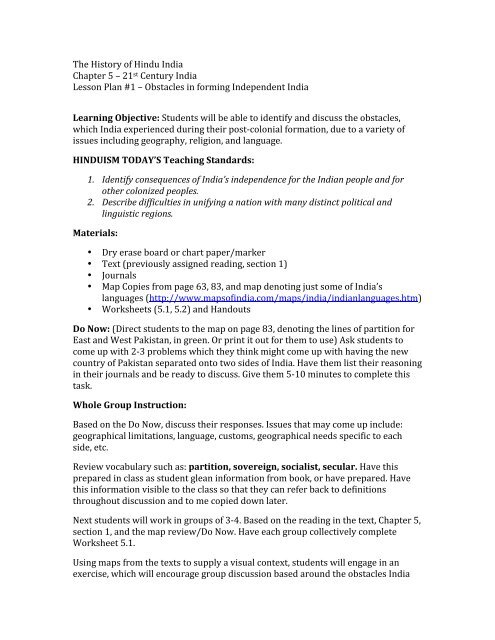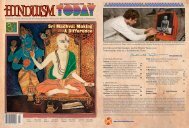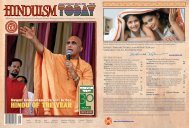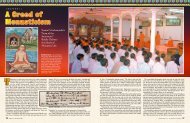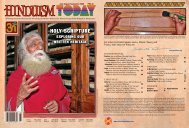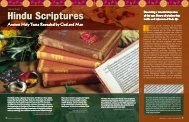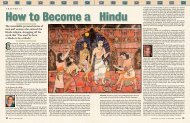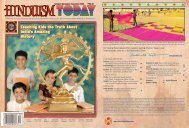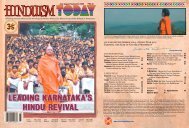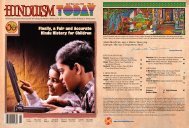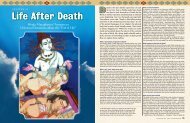The History of Hindu India Chapter 5 - Hinduism Today Magazine
The History of Hindu India Chapter 5 - Hinduism Today Magazine
The History of Hindu India Chapter 5 - Hinduism Today Magazine
You also want an ePaper? Increase the reach of your titles
YUMPU automatically turns print PDFs into web optimized ePapers that Google loves.
<strong>The</strong> <strong>History</strong> <strong>of</strong> <strong>Hindu</strong> <strong>India</strong> <br />
<strong>Chapter</strong> 5 – 21 st Century <strong>India</strong> <br />
Lesson Plan #1 – Obstacles in forming Independent <strong>India</strong> <br />
Learning Objective: Students will be able to identify and discuss the obstacles, <br />
which <strong>India</strong> experienced during their post-‐colonial formation, due to a variety <strong>of</strong> <br />
issues including geography, religion, and language. <br />
HINDUISM TODAY’S Teaching Standards: <br />
1. Identify consequences <strong>of</strong> <strong>India</strong>’s independence for the <strong>India</strong>n people and for <br />
other colonized peoples. <br />
2. Describe difficulties in unifying a nation with many distinct political and <br />
linguistic regions. <br />
Materials: <br />
• Dry erase board or chart paper/marker <br />
• Text (previously assigned reading, section 1) <br />
• Journals <br />
• Map Copies from page 63, 83, and map denoting just some <strong>of</strong> <strong>India</strong>’s <br />
languages (http://www.maps<strong>of</strong>india.com/maps/india/indianlanguages.htm) <br />
• Worksheets (5.1, 5.2) and Handouts <br />
Do Now: (Direct students to the map on page 83, denoting the lines <strong>of</strong> partition for <br />
East and West Pakistan, in green. Or print it out for them to use) Ask students to <br />
come up with 2-‐3 problems which they think might come up with having the new <br />
country <strong>of</strong> Pakistan separated onto two sides <strong>of</strong> <strong>India</strong>. Have them list their reasoning <br />
in their journals and be ready to discuss. Give them 5-‐10 minutes to complete this <br />
task. <br />
Whole Group Instruction: <br />
Based on the Do Now, discuss their responses. Issues that may come up include: <br />
geographical limitations, language, customs, geographical needs specific to each <br />
side, etc. <br />
Review vocabulary such as: partition, sovereign, socialist, secular. Have this <br />
prepared in class as student glean information from book, or have prepared. Have <br />
this information visible to the class so that they can refer back to definitions <br />
throughout discussion and to me copied down later. <br />
Next students will work in groups <strong>of</strong> 3-‐4. Based on the reading in the text, <strong>Chapter</strong> 5, <br />
section 1, and the map review/Do Now. Have each group collectively complete <br />
Worksheet 5.1. <br />
Using maps from the texts to supply a visual context, students will engage in an <br />
exercise, which will encourage group discussion based around the obstacles <strong>India</strong>
faced soon after independence (such as issues re. geography, the Princely States, <br />
language, religion, etc). <br />
Scaffolding: <br />
After groups have compiled their responses, share out and list each group’s replies <br />
on chart paper for sharing and review. One person from each group can act as the <br />
‘presenter’ for the group. <br />
Time allowing, lead the students into independent work, which will look further into <br />
the conflict with Kashmir and <strong>India</strong>n and Pakistan. <br />
Independent Work Time and/or Homework Worksheet: <br />
Pass out worksheet #5.2. And further reading on the Kashmir conflict. Instruct <br />
students to answer the questions independently. <strong>The</strong>y should refer to reading on <br />
Kashmir on page 83 in addition to the supplemental handout. Most <strong>of</strong> this will be <br />
done as homework. Teacher should use any time here to assist students who might <br />
still have questions. <br />
Summary: <br />
Wrap up the class by stating something like “Independence takes a great deal <strong>of</strong> <br />
work and dedication….considering <strong>India</strong> was under colonial rule for nearly 2 <br />
decades, do you think all this work was/is worth it” Allow students to respond. <br />
• What is something else that you work hard at, which you think is well worth <br />
it Why Discuss only a few responses with the class, and then have students <br />
wrap up. <br />
Homework: <br />
Above <br />
Resources: <br />
http://www.maps<strong>of</strong>india.com/maps/india/indianlanguages.htm <br />
http://luc.devroye.org/bengali.html <br />
http://en.wikipedia.org/wiki/File:British_<strong>India</strong>n_Empire_1909_Imperial_Gazetteer_<br />
<strong>of</strong>_<strong>India</strong>.jpg <br />
http://www.insightonconflict.org/conflicts/kashmir/gclid=CIzIup2L860CFUSo4Ao<br />
dGgsQvQ <br />
Assessment: <br />
Formal Assessment: Spot check “Do Now” work in student journals, collect <br />
worksheets for review before students leave class. <br />
Informal assessment: Participation and group work/discussion.
WORKSHEET #5.1 <br />
Group Names____________________________________________________Date______________________ <br />
Obstacles in Unification <br />
Group Work <br />
1. Why would the princely states not want to join Independent <strong>India</strong> Did<br />
they have a fair enough reason now that the British were gone<br />
_________________________________________________________<br />
_________________________________________________________<br />
_________________________________________________________<br />
_________________________________________________________<br />
____________________________________________________<br />
2. Why did the northern region (now Pakistan and Bangladesh) want<br />
autonomy from the New <strong>India</strong><br />
_________________________________________________________<br />
_________________________________________________________<br />
_________________________________________________________<br />
_________________________________________________________<br />
____________________________________________________<br />
3. How could varying languages have complicated issues <strong>of</strong> unity<br />
_________________________________________________________<br />
_________________________________________________________<br />
_________________________________________________________<br />
_________________________________________________________<br />
____________________________________________________<br />
4. What are some solutions that may have aided this highly multi-lingual<br />
society<br />
_________________________________________________________<br />
_________________________________________________________<br />
_________________________________________________________<br />
_________________________________________________________<br />
____________________________________________________
HOMEWORK: WORKSHEET #5.2 <br />
Name____________________________________________________________Date______________________ <br />
KASHMIR CONFLICT PAST AND PRESENT <br />
Some conflicts that existed during <strong>India</strong>’s post-colonial formation still exist<br />
today. One <strong>of</strong> them is the dispute between Pakistan and <strong>India</strong> over the<br />
<strong>India</strong>n state <strong>of</strong> Kashmir. Re-read the passage under <strong>The</strong> Princely States, on<br />
page 83 in text, as well as the passage below. <strong>The</strong>n, respond to the<br />
questions. Your responses should be completed in essay form.<br />
Background on the Conflict Over Kashmir<br />
For Students & Teachers<br />
<strong>The</strong> Problem: Pakistan wishes to control all <strong>of</strong> Kashmir.<br />
Why is control <strong>of</strong> Kashmir is so important <strong>The</strong> geography is mostly rural, with fierce<br />
mountains, deserts, and valleys. Industry is undeveloped. If this region has natural<br />
resources such as oil or gold or silver in any quantity, this has not yet been discovered.<br />
Why the fuss<br />
1. Control <strong>of</strong> the Indus River. <strong>The</strong> headwaters <strong>of</strong> the Indus River are located in<br />
Kashmir. Whoever controls the headwaters, controls the river. <strong>The</strong> Indus is vital. It<br />
brings green fertile life wherever it flows. <strong>The</strong> Indus begins in Kashmir, then flows<br />
through Pakistan, then flows into mainland <strong>India</strong>. If <strong>India</strong> chose, since Kashmir is part<br />
<strong>of</strong> <strong>India</strong>, they could dam the Indus and change the flow <strong>of</strong> the river. Without fertile<br />
land to grow crops, Pakistan would become a desert and its people would starve.<br />
Pakistan does not trust <strong>India</strong>, nor does <strong>India</strong> trust Pakistan. <strong>The</strong>y will not share<br />
control <strong>of</strong> the Indus. <strong>The</strong>y both want total control.<br />
2. Religious Sites. Both Pakistan and <strong>India</strong> have sites in Kashmir that are important to<br />
their respective religions.<br />
* Pakistan is predominately Muslim. Kashmir is predominately Muslim.<br />
* <strong>India</strong> is predominately <strong>Hindu</strong>.<br />
3. Strategic Location. For <strong>India</strong>, Kashmir acts as a buffer. For Pakistan, Kashmir <strong>of</strong>fers<br />
a fertile roadway into <strong>India</strong> for possible invasion.<br />
Resource: (http://geography.mrdonn.org/kashmir.html#Background)<br />
1. Why do you think the Princely States were able to keep their wealth<br />
and princely standing during the British rule when so many other<br />
<strong>India</strong>n people were suffering<br />
2. When the British left, why would the princely states want to join the<br />
newly unified <strong>India</strong>
3. Why would some <strong>of</strong> these states hold out (such as Kashmir)<br />
4. Who was Maharaja Hari Singh And was he wise in delaying his<br />
decision to join <strong>India</strong> in her independence Why or why not<br />
5. After reading the handout on the Kashmir conflict today, what do you<br />
think might be some steps to a peaceful resolution
<strong>The</strong> <strong>History</strong> <strong>of</strong> <strong>Hindu</strong> <strong>India</strong> <br />
<strong>Chapter</strong> 5 – 21 st Century <strong>India</strong> <br />
Lesson Plan #2 – Forming the <strong>India</strong>n Constitution <br />
Learning Objective: Students will be able to understand the need for a constitution, <br />
and begin to compare and contrast elements <strong>of</strong> the <strong>India</strong>n Constitution with <br />
elements <strong>of</strong> the US Constitution. <br />
HINDUISM TODAY’S Teaching Standards: <br />
Materials: <br />
3. Describe the <strong>India</strong>n constitution and political system. <br />
• Dry erase board or chart paper/marker <br />
• Text (previously assigned reading: section 1) <br />
• Journals <br />
• Handouts and Worksheets (5.3) <br />
Do Now: What do you think a constitution is What is the purpose <strong>of</strong> a constitution <br />
for any country, or state or school <br />
Have students respond to these questions in their journals and be ready to discuss. <br />
Whole Group Instruction: <br />
Begin by defining -‐ constitution, elicit responses from the class and collaborate on <br />
wording. Once an agreed definition is flushed out, write this definition on chart <br />
paper, or on the board, for all to see. Read a formal definition such as <br />
A constitution is a set <strong>of</strong> fundamental principles or established precedents<br />
according to which a state or other organization is governed.<br />
(http://en.wikipedia.org/wiki/Constitution)<br />
Both definitions should reaffirm the class’s understanding <strong>of</strong> a constitution. <br />
Next, have students turn to a partner and ask them to discuss the following <br />
questions: <br />
1. Why would <strong>India</strong> need a constitution at this time in history, post-independence<br />
<br />
2. What type <strong>of</strong> issues would <strong>India</strong>’s leaders have to discuss in order to create a <br />
peaceful country, especially given their recent past <br />
Give them about 5 minutes to discuss while monitoring conversations. Have these <br />
questions written on the wall somewhere. Interject where necessary. <br />
Bring the class together again and ask for individual speakers to share a few <br />
responses with the class. Why a constitution If some <strong>of</strong> the topics below do not <br />
come up, begin to introduce the concepts:
• British authority were now gone, whose rules were not to be followed <br />
• What holidays should be observed <br />
• Which customs will they follow <br />
• Will there be a President <strong>of</strong> the country, or a Raj, or a Prime Minister, or a <br />
Queen <br />
• How many states will there be <br />
• What language should everyone speak <br />
• What laws should this new country impose on its society <br />
As students begin to answer, have them write their brief answer on prepared chart <br />
paper in the front <strong>of</strong> the class. As a student writes answers on chart paper, ask for <br />
other reason why a constitution was needed. <br />
Summary: <br />
After independence <strong>India</strong> needed a constitution that would convey and protect the <br />
values that <strong>India</strong> had fought so hard to secure. 370 million people were set free after <br />
the British Raj left <strong>India</strong>, now was the time to secure <strong>India</strong>’s strength for future years <br />
to come. <br />
Homework: <br />
Have the students compare and contrast some basic facts about the US and <strong>India</strong> <br />
constitutions. Provide them with the information below summarizing both <br />
constitutions. <br />
Provide them with a Homework/compare and contrast sheet as well as a copy from <br />
the Wikipedia Dictionary, summarizing facets <strong>of</strong> both constitutions. Encourage <br />
students to find supplemental resources too. <br />
Resources: <br />
http://en.wikipedia.org/wiki/Constitution_<strong>of</strong>_<strong>India</strong> <br />
http://en.wikipedia.org/wiki/United_States_Constitution <br />
http://en.wikipedia.org/wiki/Constitution <br />
Assessment: <br />
Formal Assessment: Spot-‐check “Do Now” work in student journals; collect <br />
worksheets for review before students leave class. <br />
Informal assessment: Participation and group work/discussion.
Homework Reading Handout <br />
COMPARE AND CONTRAST CONSTITUTIONS: <br />
INDIA AND THE UNITED STATES <br />
<strong>The</strong> Constitution <strong>of</strong> <strong>India</strong> is the supreme law <strong>of</strong> <strong>India</strong>. It lays down the framework<br />
defining fundamental political principles, establishes the structure, procedures, powers,<br />
and duties <strong>of</strong> government institutions, and sets out fundamental rights, directive<br />
principles, and the duties <strong>of</strong> citizens. It is the longest [1] written constitution <strong>of</strong> any<br />
sovereign country in the world, containing 450 [Note 1] articles in 24 parts, 12 schedules and<br />
[citation needed]<br />
96 amendments, for a total <strong>of</strong> 117,369 words in the English language version.<br />
Besides the English version, there is an <strong>of</strong>ficial Hindi translation.<br />
<strong>The</strong> Constitution was enacted by the Constituent Assembly on 26 November 1949, and<br />
came into effect on 26 January 1950. [2] <strong>The</strong> date 26 January was chosen to commemorate<br />
the Purna Swaraj declaration <strong>of</strong> independence <strong>of</strong> 1930. With its adoption, the Union <strong>of</strong><br />
<strong>India</strong> <strong>of</strong>ficially became the modern and contemporary Republic <strong>of</strong> <strong>India</strong> and it replaced<br />
the Government <strong>of</strong> <strong>India</strong> Act 1935 as the country's fundamental governing document.<br />
<strong>The</strong> Constitution declares <strong>India</strong> to be a sovereign, socialist, secular, democratic republic,<br />
assuring its citizens <strong>of</strong> justice, equality, and liberty, and endeavours to promote fraternity<br />
among them. <strong>The</strong> words "socialist" and "secular" were added to the definition in 1976 by<br />
constitutional amendment. [3] <strong>India</strong> celebrates the adoption <strong>of</strong> the constitution on 26<br />
January each year as Republic Day. [4]<br />
Source: http://en.wikipedia.org/wiki/Constitution_<strong>of</strong>_<strong>India</strong><br />
___<br />
<strong>The</strong> Constitution <strong>of</strong> the United States is the supreme law <strong>of</strong> the United States <strong>of</strong><br />
America. <strong>The</strong> first three Articles <strong>of</strong> the Constitution establish the rules and separate<br />
powers <strong>of</strong> the three branches <strong>of</strong> the federal government: a legislature, the bicameral<br />
Congress; an executive branch led by the President; and a federal judiciary headed by the<br />
Supreme Court. <strong>The</strong> last four Articles frame the principle <strong>of</strong> federalism. <strong>The</strong> Tenth<br />
Amendment confirms its federal characteristics.<br />
<strong>The</strong> Constitution was adopted on September 17, 1787, by the Constitutional Convention<br />
in Philadelphia, Pennsylvania, and ratified by conventions in eleven states. <strong>The</strong> first ten<br />
amendments are known as the Bill <strong>of</strong> Rights. <strong>The</strong> Constitution has been amended<br />
seventeen times (for a total <strong>of</strong> 27 amendments) and its principles are applied in courts <strong>of</strong><br />
law by judicial review.<br />
<strong>The</strong> Constitution guides American society in law and political culture. It is the oldest<br />
charter <strong>of</strong> supreme law in continuous use, and it influenced later international figures<br />
establishing national constitutions. Recent impulses for reform center on concerns for<br />
extending democracy and balancing the Federal budget.<br />
Source: http://en.wikipedia.org/wiki/United_States_Constitution
HOMEWORK: WORKSHEET #5.3 <br />
Name____________________________________________________________Date______________________ <br />
COMPARE AND CONTRAST CONSTITUTIONS: <br />
INDIA AND THE UNITED STATES <br />
Refer to handout to find answers.<br />
When was the<br />
constitution enacted or<br />
adopted<br />
Who/Which department<br />
approved it<br />
INDIA<br />
UNITED STATES<br />
What is the <strong>of</strong>ficial name<br />
<strong>of</strong> the government,<br />
according to its<br />
constitution<br />
How many amendments<br />
does this constitution<br />
have List one amendment<br />
from this constitution.<br />
Does this country<br />
celebrate its<br />
independence If so, list<br />
the day <strong>of</strong> observance.<br />
(Independent Research…)<br />
Who were key<br />
writers/contributors to<br />
this constitution
<strong>The</strong> <strong>History</strong> <strong>of</strong> <strong>Hindu</strong> <strong>India</strong> <br />
<strong>Chapter</strong> 5 – 21 st Century <strong>India</strong> <br />
Lesson Plan #3 – Economic, Secular and Social Developments for <strong>India</strong> <br />
Learning Objective: Students will begin to recognize how economic development <br />
works through a brief overview <strong>of</strong> <strong>India</strong>n’s post-‐independence, economic <br />
development. <br />
HINDUISM TODAY’S Teaching Standards: <br />
Materials: <br />
6. Examine <strong>India</strong>’s political, technological, economic, social, and secular <br />
developments since 1947. <br />
• Dry erase board or chart paper/marker <br />
• Text (previously assigned reading: section 2) <br />
• Journals <br />
• Handouts and Worksheets (5.4, 5.5) <br />
Do Now: Ask students to re-‐read the passage on page 64: “<strong>The</strong> British Raj”. From <br />
here, direct them to find two ways that the British Raj strengthened their economy <br />
during their occupation <strong>of</strong> <strong>India</strong>. Have students write this in their Journal. <br />
Whole Group Instruction: <br />
Begin the whole group discussion responding to the Do Now task. Ask students for <br />
answers to the question. One way the British strengthened their economy was <br />
allowing British goods to travel ‘duty-‐free’/without being taxed, all over <strong>India</strong>. Taxes <br />
that should have been paid to <strong>India</strong> were lost. Also, due to all these “duty-‐free’ <br />
British products, native-‐<strong>India</strong>n industries suffered, again further strengthening the <br />
British Raj’s power over <strong>India</strong>. <br />
Before you go any further define economy for the class. <br />
e·con·o·my<br />
noun /iˈkänəmē/<br />
1. <strong>The</strong> wealth and resources <strong>of</strong> a country or region, esp. in terms <strong>of</strong> the production and<br />
consumption <strong>of</strong> goods and services<br />
Guide the discussion into <strong>India</strong>’s economy. Based on the students up to date reading <br />
<strong>of</strong> the text, what are some economic resources/wealth that <strong>India</strong> possesses, then <br />
and now. List these responses on chart paper or board under: <strong>India</strong>’s economic <br />
resources. Some replies will include natural resources, labor force, buying <br />
power/consumer power, manufactured goods, etc. <br />
After the class has collectively brainstormed a list <strong>of</strong> <strong>India</strong>’s resources have them <br />
break up into 4 groups (about 4 students in each group).
Group work will include synthesizing an era <strong>of</strong> <strong>India</strong>’s economy. <strong>The</strong>se era’s are: <br />
pre-‐colonial period, colonial period, pre-‐liberalization period and post-liberalization<br />
period. Each group will have a reading based on one time period/era. <br />
<strong>The</strong>y will discuss the reading together to come up with answers for their worksheet. <br />
One student will anecdote group answers, another student will present their group’s <br />
finding when time is through. This will provide the entire class with a brief synopsis <br />
on all four periods and the shift in economic shifts in history. <br />
Summary: <br />
Summarize the impact <strong>of</strong> the British Raj by eliciting the responses from the class, <br />
while reviewing the wealth <strong>of</strong> economic resources that <strong>India</strong> possesses. Students <br />
should come up with deductive reasoning as to the importance <strong>of</strong> <strong>India</strong>’s economy <br />
and why the British valued <strong>India</strong> so much. Conclude class. <br />
Homework: <br />
Using the text and independent research, give the students homework sheet to <br />
complete for the next class. (homework sheet 5.5) <br />
Resources: <br />
http://en.wikipedia.org/wiki/Economy_<strong>of</strong>_<strong>India</strong> <br />
Assessment: <br />
Formal Assessment: Spot check “Do Now” work in student journals, collect <br />
worksheets for review before students leave class. <br />
Informal assessment: Participation and group work/discussion.
HANDOUT/Group 1 <br />
Pre-colonial period (up to 1773) <br />
<strong>The</strong> citizens <strong>of</strong> the Indus Valley civilization, a permanent settlement that flourished between 2800<br />
BC and 1800 BC, practiced agriculture, domesticated animals, used uniform weights and<br />
measures, made tools and weapons, and traded with other cities. Evidence <strong>of</strong> well-planned streets,<br />
a drainage system and water supply reveals their knowledge <strong>of</strong> urban planning, which included<br />
the world's first urban sanitation systems and the existence <strong>of</strong> a form <strong>of</strong> municipal government. [20]<br />
<strong>The</strong> economically important Silk Road (red) and spice trade routes (blue). <strong>The</strong> spice trade <br />
between <strong>India</strong> and Europe was the main catalyst for the Age <strong>of</strong> Discovery. [21] <br />
Maritime trade was carried out extensively between South <strong>India</strong> and southeast and West Asia<br />
from early times until around the fourteenth century AD. Both the Malabar and Coromandel<br />
Coasts were the sites <strong>of</strong> important trading centres from as early as the first century BC, used for<br />
import and export as well as transit points between the Mediterranean region and southeast<br />
Asia. [22] Over time, traders organized themselves into associations which received state patronage.<br />
However, state patronage for overseas trade came to an end by the thirteenth century AD, when it<br />
was largely taken over by the local Parsi, Jewish and Muslim communities, initially on the<br />
Malabar and subsequently on the Coromandel coast. [23] Further north, the Saurashtra and Bengal<br />
coasts played an important role in maritime trade, and the Gangetic plains and the Indus valley<br />
housed several centres <strong>of</strong> river-borne commerce. Most overland trade was carried out via the<br />
Khyber Pass connecting the Punjab region with Afghanistan and onward to the Middle East and<br />
Central Asia. [24] Although many kingdoms and rulers issued coins, barter was prevalent. Villages<br />
paid a portion <strong>of</strong> their agricultural produce as revenue to the rulers, while their craftsmen received<br />
a part <strong>of</strong> the crops at harvest time for their services. [25]<br />
Assessment <strong>of</strong> <strong>India</strong>'s pre-colonial economy is mostly qualitative, owing to the lack <strong>of</strong><br />
quantitative information. <strong>The</strong> Mughal economy functioned on an elaborate system <strong>of</strong> coined<br />
currency, land revenue and trade. Gold, silver and copper coins were issued by the royal mints<br />
which functioned on the basis <strong>of</strong> free coinage. [26] <strong>The</strong> political stability and uniform revenue<br />
policy resulting from a centralised administration under the Mughals, coupled with a welldeveloped<br />
internal trade network, ensured that <strong>India</strong>, before the arrival <strong>of</strong> the British, was to a<br />
large extent economically unified, despite having a traditional agrarian economy characterised by<br />
a predominance <strong>of</strong> subsistence agriculture dependent on primitive technology. [27] After the decline<br />
<strong>of</strong> the Mughals, western, central and parts <strong>of</strong> south and north <strong>India</strong> were integrated and<br />
administered by the Maratha Empire. After the loss at the Third Battle <strong>of</strong> Panipat, the Maratha<br />
Empire disintegrated into several confederate states, and the resulting political instability and<br />
armed conflict severely affected economic life in several parts <strong>of</strong> the country, although this was
compensated for to some extent by localised prosperity in the new provincial kingdoms. [28] By the<br />
end <strong>of</strong> the eighteenth century, the British East <strong>India</strong> Company entered the <strong>India</strong>n political theatre<br />
and established its dominance over other European powers. This marked a determinative shift in<br />
<strong>India</strong>'s trade, and a less powerful impact on the rest <strong>of</strong> the economy. [29]<br />
(Source: http://en.wikipedia.org/wiki/Economy_<strong>of</strong>_<strong>India</strong> )
HANDOUT/GROUP 2 <br />
Colonial period (1773–1947)<br />
Company rule in <strong>India</strong> brought a major change in the taxation and agricultural policies, which<br />
tended to promote commercialisation <strong>of</strong> agriculture with a focus on trade, resulting in decreased<br />
production <strong>of</strong> food crops, mass impoverishment and destitution <strong>of</strong> farmers, and in the short term,<br />
led to numerous famines. [31] <strong>The</strong> economic policies <strong>of</strong> the British Raj caused a severe decline in<br />
the handicrafts and handloom sectors, due to reduced demand and dipping employment. [32] After<br />
the removal <strong>of</strong> international restrictions by the Charter <strong>of</strong> 1813, <strong>India</strong>n trade expanded<br />
substantially and over the long term showed an upward trend. [33] <strong>The</strong> result was a significant<br />
transfer <strong>of</strong> capital from <strong>India</strong> to England, which, due to the colonial policies <strong>of</strong> the British, led to<br />
a massive drain <strong>of</strong> revenue rather than any systematic effort at modernisation <strong>of</strong> the domestic<br />
economy. [34]<br />
<strong>India</strong>'s colonisation by the British created an institutional environment that, on paper, guaranteed<br />
property rights among the colonisers, encouraged free trade, and created a single currency with<br />
fixed exchange rates, standardised weights and measures and capital markets. It also established a<br />
well-developed system <strong>of</strong> railways and telegraphs, a civil service that aimed to be free from<br />
political interference, a common-law and an adversarial legal system. [36] This coincided with<br />
major changes in the world economy – industrialisation, and significant growth in production and<br />
trade. However, at the end <strong>of</strong> colonial rule, <strong>India</strong> inherited an economy that was one <strong>of</strong> the<br />
poorest in the developing world, [37] with industrial development stalled, agriculture unable to feed<br />
a rapidly growing population, a largely illiterate and unskilled labour force, and extremely<br />
inadequate infrastructure. [38]<br />
<strong>The</strong> 1872 census revealed that 91.3% <strong>of</strong> the population <strong>of</strong> the region constituting present-day<br />
<strong>India</strong> resided in villages, [39] and urbanisation generally remained sluggish until the 1920s, due to<br />
the lack <strong>of</strong> industrialisation and absence <strong>of</strong> adequate transportation. Subsequently, the policy <strong>of</strong><br />
discriminating protection (where certain important industries were given financial protection by<br />
the state), coupled with the Second World War, saw the development and dispersal <strong>of</strong> industries,<br />
encouraging rural-urban migration, and in particular the large port cities <strong>of</strong> Bombay, Calcutta and<br />
Madras grew rapidly. Despite this, only one-sixth <strong>of</strong> <strong>India</strong>'s population lived in cities by 1951. [40]<br />
<strong>The</strong> impact <strong>of</strong> the British rule on <strong>India</strong>'s economy is a controversial topic. Leaders <strong>of</strong> the <strong>India</strong>n<br />
independence movement and left-wing people who opposed <strong>India</strong>'s independence movement,<br />
economic historians have blamed colonial rule for the dismal state <strong>of</strong> <strong>India</strong>'s economy in its<br />
aftermath and argued that financial strength required for industrial development in Europe was<br />
derived from the wealth taken from colonies in Asia and Africa. At the same time, right-wing<br />
historians have countered that <strong>India</strong>'s low economic performance was due to various sectors being<br />
in a state <strong>of</strong> growth and decline due to changes brought in by colonialism and a world that was<br />
moving towards industrialisation and economic integration. [41]<br />
(Source: http://en.wikipedia.org/wiki/Economy_<strong>of</strong>_<strong>India</strong> )
HANDOUT/GROUP 3 <br />
Pre-liberalisation period (1947–1991) <br />
<strong>India</strong>n economic policy after independence was influenced by the colonial experience, which was<br />
seen by <strong>India</strong>n leaders as exploitative, and by those leaders' exposure to democratic socialism as<br />
well as the progress achieved by the economy <strong>of</strong> the Soviet Union. [38] Domestic policy tended<br />
towards protectionism, with a strong emphasis on import substitution industrialisation, economic<br />
interventionism, a large public sector, business regulation, and central planning, [42] while trade<br />
and foreign investment policies were relatively liberal. [43] Five-Year Plans <strong>of</strong> <strong>India</strong> resembled<br />
central planning in the Soviet Union. Steel, mining, machine tools, telecommunications,<br />
insurance, and power plants, among other industries, were effectively nationalised in the mid-<br />
1950s. [44]<br />
Jawaharlal Nehru, the first prime minister <strong>of</strong> <strong>India</strong>, along with the statistician Prasanta Chandra<br />
Mahalanobis, formulated and oversaw economic policy during the initial years <strong>of</strong> the country's<br />
existence. <strong>The</strong>y expected favorable outcomes from their strategy, involving the rapid<br />
development <strong>of</strong> heavy industry by both public and private sectors, and based on direct and<br />
indirect state intervention, rather than the more extreme Soviet-style central command<br />
system. [45][46] <strong>The</strong> policy <strong>of</strong> concentrating simultaneously on capital- and technology-intensive<br />
heavy industry and subsidising manual, low-skill cottage industries was criticised by economist<br />
Milton Friedman, who thought it would waste capital and labour, and retard the development <strong>of</strong><br />
small manufacturers. [47] <strong>The</strong> rate <strong>of</strong> growth <strong>of</strong> the <strong>India</strong>n economy in the first three decades after<br />
independence was derisively referred to as the <strong>Hindu</strong> rate <strong>of</strong> growth by economists, because <strong>of</strong><br />
the unfavourable comparison with growth rates in other Asian countries. [48][49]<br />
Since 1965, the use <strong>of</strong> high-yielding varieties <strong>of</strong> seeds, increased fertilisers and improved<br />
irrigation facilities collectively contributed to the Green Revolution in <strong>India</strong>, which improved the<br />
condition <strong>of</strong> agriculture by increasing crop productivity, improving crop patterns and<br />
strengthening forward and backward linkages between agriculture and industry. [50] However, it<br />
has also been criticised as an unsustainable effort, resulting in the growth <strong>of</strong> capitalistic farming,<br />
ignoring institutional reforms and widening income disparities. [51]<br />
(Source: http://en.wikipedia.org/wiki/Economy_<strong>of</strong>_<strong>India</strong> )
HANDOUT/GROUP 4 <br />
Post-liberalisation period (since 1991) <br />
In the late 1970s, the government led by Morarji Desai eased restrictions on capacity expansion<br />
for incumbent companies, removed price controls, reduced corporate taxes and promoted the<br />
creation <strong>of</strong> small scale industries in large numbers. He also raised the income tax levels at one<br />
point to a maximum <strong>of</strong> 97.5%, a record in the world for non-communist economies. However, the<br />
subsequent government policy <strong>of</strong> Fabian socialism hampered the benefits <strong>of</strong> the economy,<br />
leading to high fiscal deficits and a worsening current account. <strong>The</strong> collapse <strong>of</strong> the Soviet Union,<br />
which was <strong>India</strong>'s major trading partner, and the Gulf War, which caused a spike in oil prices,<br />
resulted in a major balance-<strong>of</strong>-payments crisis for <strong>India</strong>, which found itself facing the prospect <strong>of</strong><br />
defaulting on its loans. [52] <strong>India</strong> asked for a $1.8 billion bailout loan from the International<br />
Monetary Fund (IMF), which in return demanded reforms. [53]<br />
In response, Prime Minister Narasimha Rao, along with his finance minister Manmohan Singh,<br />
initiated the economic liberalisation <strong>of</strong> 1991. <strong>The</strong> reforms did away with the Licence Raj, reduced<br />
tariffs and interest rates and ended many public monopolies, allowing automatic approval <strong>of</strong><br />
foreign direct investment in many sectors. [54] Since then, the overall thrust <strong>of</strong> liberalisation has<br />
remained the same, although no government has tried to take on powerful lobbies such as trade<br />
unions and farmers, on contentious issues such as reforming labour laws and reducing agricultural<br />
subsidies. [55] By the turn <strong>of</strong> the 20th century, <strong>India</strong> had progressed towards a free-market<br />
economy, with a substantial reduction in state control <strong>of</strong> the economy and increased financial<br />
liberalisation. [56] This has been accompanied by increases in life expectancy, literacy rates and<br />
food security, although the beneficiaries have largely been urban residents. [57]<br />
While the credit rating <strong>of</strong> <strong>India</strong> was hit by its nuclear weapons tests in 1998, it has since been<br />
raised to investment level in 2003 by S&P and Moody's. [58] In 2003, Goldman Sachs predicted<br />
that <strong>India</strong>'s GDP in current prices would overtake France and Italy by 2020, Germany, UK and<br />
Russia by 2025 and Japan by 2035, making it the third largest economy <strong>of</strong> the world, behind the<br />
US and China. <strong>India</strong> is <strong>of</strong>ten seen by most economists as a rising economic superpower and is<br />
believed to play a major role in the global economy in the 21st century. [59][60]<br />
(Source: http://en.wikipedia.org/wiki/Economy_<strong>of</strong>_<strong>India</strong> )
WORKSHEET #5.4 <br />
Group Names____________________________________________________Date______________________ <br />
<strong>India</strong>’s Economic Shifts <br />
Based on the group reading, collectively complete the fact-finding sheet<br />
below. If you don’t know a word, read around the word to find meaning. One<br />
person from you group may be the ‘dictionary look-up’, IF necessary.<br />
Economic Period:<br />
Duration:<br />
Positive Aspects <strong>of</strong> this period:<br />
1.<br />
2.<br />
3.<br />
Negative Aspects <strong>of</strong> this period:<br />
1.<br />
2.<br />
3.<br />
Was this a good economic time for <strong>India</strong> Explain what was going on to make<br />
it so.<br />
Who was in power during this period
HOMEWORK: WORKSHEET #5.5 <br />
Name____________________________________________________________Date______________________ <br />
INDIA’S DEVELOPMENT: After Independence <br />
<strong>India</strong> has grown in many different ways since 1947. After the British left, <strong>India</strong><br />
made strides to remain a unified and strong country. Based on the reading from<br />
your text in <strong>Chapter</strong> 5, Section 2, summarize each form <strong>of</strong> development in 3-4<br />
sentences.<br />
Political Developments:<br />
Economic Developments:<br />
Religious and Social Developments:<br />
Do you think that life for an average <strong>India</strong>n citizen is better now than it was<br />
before independence Provide a few reasons to support your answer.
<strong>The</strong> <strong>History</strong> <strong>of</strong> <strong>Hindu</strong> <strong>India</strong> <br />
<strong>Chapter</strong> 5 – 21 st Century <strong>India</strong> <br />
Lesson Plan #4 – <strong>Hindu</strong> Ideas <strong>Today</strong> <br />
Learning Objective: Students will begin to define and identify some metaphysical <br />
concepts as they exist in their society today. <br />
HINDUISM TODAY’S Teaching Standards: <br />
Materials: <br />
9. Analyze the influence <strong>of</strong> <strong>Hindu</strong> metaphysics, theology, yoga, and meditation <br />
in the Western world today. <br />
• Dry erase board or chart paper/marker <br />
• Text (reading assignment, <strong>Chapter</strong> 5.3) <br />
• Journals <br />
Do Now: Have students re-‐read pages 90-‐91 in <strong>Chapter</strong> 5, section 3. Give them the <br />
task <strong>of</strong> 1) defining metaphysics, 2) providing two example <strong>of</strong> it from the book and 3) <br />
providing two more examples that are not found in the book, but are from their own <br />
frame <strong>of</strong> reference (ie. Ideas from their home religion, ideas about outer space, or <br />
beliefs about a pet that may have died. Something that our senses cannot validate, <br />
but that we try to understand and sometimes even believe to be valid, even though <br />
there is no tangible pro<strong>of</strong>, just possibility.) <br />
Whole Group Instruction: <br />
After the Do Now, define the term for the class, as it is stated in the book and also <br />
supplement where you feel appropriate for your class. Have them copy these <br />
definitions in their journals. <br />
Metaphysics – the study <strong>of</strong> reality beyond our five senses. (text: page 91) <br />
OR <br />
Metaphysics – the branch <strong>of</strong> philosophy that examines the nature <strong>of</strong> reality, <br />
including the relationship between mind and matter, substance and attribute, <br />
fact and value. (http://www.thefreedictionary.com/metaphysics) <br />
Find definitions that you are able to work with as a teacher keeping a basic and <br />
objective perspective for the students to work around. This is a very abstract <br />
concept. And remember to bring back conversation to the <strong>Hindu</strong> beliefs and customs <br />
and traditions. It will ultimately provide a framework under which students can <br />
examine and begin to understand some basic concepts having to do with <strong>Hindu</strong> <br />
customs and practices and the idea <strong>of</strong> metaphysics.
After defining and discussing this term, ask students to come up with a metaphysical <br />
happening or event, using our definitions. <strong>The</strong>y can get these responses from the Do <br />
Now exercise. I like the idea <strong>of</strong> outer space study. As humans we only know so much <br />
due to obvious limitations. We believe what science can show us, but so much is <br />
limited. What are our beliefs about that <br />
Scaffolding: <br />
Using a diagram on chart paper, allow the students to share out their ideas on <br />
metaphysics. And collectively assess if the idea/concept can be perceived or <br />
explained through our senses. <br />
Example: <br />
Idea: Life in outer space <br />
Can I see if there is life No <br />
Can I taste if there is life No <br />
Can I hear if there is life No <br />
Can I feel if there is life No <br />
Can I smell if it there is life No <br />
What are some <strong>of</strong> our ‘ideas’ about life in outer space Where do they come from <br />
We collect assumptions/hypothesis that may be logical. We incorporate knowledge <br />
and experience when considering a reality. Or we openly believe something or not. <br />
Technically, would this be a metaphysical concept Can we prove that NO life exists <br />
in outer space <br />
Have class break up into pairs and discuss their ideas on life in outer space with <br />
each other. Tell them that it is fine to disagree with their partner. <strong>The</strong>y don’t need an <br />
explanation, however, try to foster an open, ‘anything is possible’, area for safe <br />
discussion. After about 5-‐6 minutes <strong>of</strong> discussion begin to summarize. <br />
Summary: <br />
Summarize the lesson by asking students about <strong>Hindu</strong> beliefs (covered in chapter <br />
1). Many <strong>Hindu</strong> beliefs and practices have been brought to the West and we are now <br />
beginning to adopt many, even though we are not necessarily <strong>Hindu</strong>. <br />
2). <strong>Hindu</strong> people are spiritual/religious people <br />
3). <strong>The</strong> idea <strong>of</strong> tolerance has enabled <strong>Hindu</strong> ideas to be welcomed and accepted all <br />
over the Western world today.
Ask the students to close their books and sit up straight in their chairs as if a book <br />
was balancing on their head. Ask them to place feet directly flat on floor and hands <br />
on their lap. Have them take a few slow, deep breaths, exhaling any old, stagnant air <br />
inside. Dim the lights if possible and have them close the eyes (it is ok, if some what <br />
to keep them open, just direct them to a focus point). Breathing normally, direct <br />
them to count their breaths up to 7, slowly and silently. <strong>The</strong>n repeat. <strong>The</strong>re may be <br />
giggling or restlessness at first, but just listen to the class and join them. <br />
When they are through, they will open their eyes. Ask them how they feel. <strong>The</strong>n <br />
explain that this was meditation, another practice from <strong>Hindu</strong> culture. <br />
Let the students know that the homework will go further into these concepts and <br />
the readings from chapter 5, section 3. <br />
Homework: <br />
Each student will briefly define key <strong>Hindu</strong> ideas which have flourished in the west <br />
today. <strong>The</strong>n identify the benefits <strong>of</strong> the practices. Lastly, they will share where they <br />
may have witnessed these ideas in their communities. All shared on the homework <br />
sheet. (5.6) <br />
Resources: <br />
http://www.pbs.org/faithandreason/gengloss/metaph-‐body.html <br />
Assessment: <br />
Formal Assessment: Spot check “Do Now” work in student journals, collect <br />
worksheets for review before students leave class. <br />
Informal assessment: Participation and group work/discussion.
HOMEWORK: WORKSHEET #5.6 <br />
Name____________________________________________________________Date______________________ <br />
<strong>Hindu</strong> Ideas <strong>Today</strong>: Metaphysics, <strong>The</strong>ology, Yoga & Meditation <br />
Refer to <strong>Chapter</strong> 5, pages 91-93 to complete this worksheet.<br />
1. Define metaphysics as you understand it. Do your best.<br />
2. What is yoga to the majority <strong>of</strong> the West<br />
3. How is yoga defined to <strong>Hindu</strong>s<br />
4. What is meditation<br />
5. What is the purpose <strong>of</strong> meditation to <strong>Hindu</strong>s<br />
6. Do you think you could meditate (if so, write down how many minutes you<br />
succeeded in quiet meditation. 1 minute 3 minutes)<br />
7. Was it easy or difficult How did it feel Explain.<br />
8. What is theology<br />
9. Does your family follow a specific form <strong>of</strong> theology If so, what is it<br />
10. Have you seen any <strong>of</strong> these or other <strong>Hindu</strong> Ideas <strong>of</strong>fered in your community<br />
Where
<strong>The</strong> <strong>History</strong> <strong>of</strong> <strong>Hindu</strong> <strong>India</strong> <br />
<strong>Chapter</strong> 5 – 21 st Century <strong>India</strong> <br />
Lesson Plan #5 – <strong>Hindu</strong> Culture in the West <strong>Today</strong> <br />
Learning Objective: <br />
1. Students will review the history <strong>of</strong> <strong>India</strong>n Immigration to Australia as ONE <br />
example <strong>of</strong> <strong>India</strong>n migration in the world. <br />
2. Students will examine some <strong>of</strong> <strong>India</strong>’s power known as ‘s<strong>of</strong>t powers’ and hard <br />
powers and track some <strong>of</strong> their development in the West. <br />
HINDUISM TODAY’S Teaching Standards: <br />
Materials: <br />
10. Describe how <strong>India</strong>n culture found its way to the West, including medicine, <br />
movies and food. <br />
• Dry erase board or chart paper/marker <br />
• Text <br />
• Journals <br />
• Article class copies: <br />
http://museumvictoria.com.au/origins/history.aspxpid=26 <br />
• Map from page 96 &97 in text, enlarged if possible. Or refer to text <br />
• Homework sheet and readings <br />
Do Now: Referring to map on page 96-‐97 in text, ask students to find the number <strong>of</strong> <br />
<strong>Hindu</strong>s presently residing in the country <strong>of</strong> Australia. Making smart guesses, list 3-‐5 <br />
reasons you think that <strong>India</strong>n people may have migrated there. List these responses <br />
in your journal. <br />
Whole Group Instruction: <br />
Display a few Australia facts, written down on chart paper for the class to see. As <br />
well as a Map is available. <br />
1. Australia is a very large country, however only has the approximate <br />
population equal to the STATE <strong>of</strong> New York (not a lot <strong>of</strong> people). <br />
2. Most <strong>of</strong> the land on Australia is uninhabitable, due to desert-‐like conditions. <br />
3. Australia is a large island, not connected to any other countries. <br />
4. Most Australians come from British ancestors. <br />
Begin the discussion. Write down some <strong>of</strong> the responses the class may have in <br />
response to the Do Now. List: “Some possible reasons for the migration <strong>of</strong> <strong>India</strong>ns to <br />
Australia”.
Next, hand out the article on “<strong>History</strong> <strong>of</strong> Immigration from <strong>India</strong>”. Ask the class to <br />
read this article, highlighting all the reasons that are mentioned in the article, for <br />
<strong>India</strong>n migration to this country. <br />
After giving them about 10 minutes to complete the reading and research, create <br />
another list for reasons behind the migration. “More reasons for Immigration to <br />
Australia”. <br />
This exercise will help students begin forming idea about immigration on their own, <br />
especially given all the study on <strong>India</strong> and <strong>Hindu</strong>ism. <strong>The</strong> supplemental reasoning <br />
will further provide a perspective <strong>of</strong> <strong>India</strong>n-‐<strong>Hindu</strong> culture from abroad. <br />
Summary: <br />
This example <strong>of</strong> <strong>India</strong>n Immigration to Australia is only one study which helps <br />
explain the various reasons <strong>India</strong>n populations can be found all over the world. <br />
Regardless <strong>of</strong> the extremely different culture, geography, or climate, <strong>India</strong>n culture <br />
and identity has remained not only strong and intact, but popular to people from <br />
other cultures as well. This is a phenomenon we will review more in our homework <br />
exercise. <br />
Homework: <br />
After reviewing the reasons for <strong>India</strong>’s immigration all over the globe, students will <br />
examine the ‘s<strong>of</strong>t’ and ‘hard’ power that <strong>India</strong> and the <strong>Hindu</strong> culture whether from <br />
home or abroad. <br />
Student homework will be to use pages 98-‐99 from the text, as well as two reading <br />
handouts to help list and differentiate <strong>India</strong>’s ‘s<strong>of</strong>t’ and ‘hard’ powers in the world <br />
today. <br />
Resources: <br />
http://www.nytimes.com/2011/10/09/nyregion/in-‐yoga-‐classes-‐at-‐schools-teachers-‐avoid-‐the-‐spiritual.html<br />
<br />
http://www.abc-‐<strong>of</strong>-‐yoga.com/beginnersguide/yogahistory.asp <br />
http://museumvictoria.com.au/origins/history.aspxpid=26 <br />
Assessment: <br />
Formal Assessment: Spot-‐check “Do Now” work in student journals; collect <br />
worksheets for review before students leave class. <br />
Informal assessment: Participation and group work/discussion.
HOMEWORK: WORKSHEET #5.7 <br />
Name____________________________________________________________Date______________________ <br />
“S<strong>of</strong>t Powers” and “Hard Powers” <strong>of</strong> <strong>India</strong> <strong>Today</strong> <br />
As our reading defined (pg. 90), Hard power is a nation’s military and/or economic <br />
strength used to impact international affairs. S<strong>of</strong>t power refers to the influence <strong>of</strong> a <br />
nation’s ideas, culture and values on the way others believe, think and act. <br />
Referring to our lessons from the text, thus far, as well as the excerpts from two <br />
articles below, respond to the questions that follow. <br />
A. After reading more about one <strong>of</strong> <strong>India</strong>’s s<strong>of</strong>t powers (yoga), can you list 3<br />
reasons why it might be popular in the West<br />
1.<br />
2.<br />
3.<br />
B. List 2 or 3 other s<strong>of</strong>t powers which <strong>India</strong>n shares all over the world<br />
today.<br />
1.<br />
2.<br />
3.<br />
C. List two aspects that have strengthened <strong>India</strong>’s hard powers in the world.<br />
(Refer to article or text, <strong>Chapter</strong> 5).<br />
1.<br />
2.<br />
D. What happened after <strong>India</strong> adopted free market principles and opened up<br />
to a lot more international trade<br />
Can you make a connection between <strong>India</strong>’s s<strong>of</strong>t powers and hard powers in<br />
the global world today Think about concepts such as tolerance, theology,
and the “Six key <strong>Hindu</strong> Ideas for <strong>Today</strong>” (page 98). Could one possible affect<br />
the other Write in paragraph form here.<br />
Do you think you would want to share in experiencing some <strong>of</strong> <strong>India</strong>’s <strong>Hindu</strong><br />
culture (s<strong>of</strong>t powers) If so which facet <strong>of</strong> it would you like to try Why.
READING HANDOUT <br />
Excerpt from: <strong>History</strong> <strong>of</strong> Yoga - A Complete Overview <strong>of</strong> the<br />
Yoga <strong>History</strong><br />
Written by: shaynebance<br />
Yoga was introduced in the West during the early 19th century. It was first studied as part<br />
<strong>of</strong> Eastern Philosophy and began as a movement for health and vegetarianism around the<br />
1930's. By the 1960's, there was an influx <strong>of</strong> <strong>India</strong>n teachers who expounded on Yoga.<br />
One <strong>of</strong> them was Maharishi Mahesh, the Yogi who popularized Transcendental<br />
Meditation. Another one is a prominent Yoga Guru Swami Sivananda. Sivananda was a<br />
doctor in Malaysia and he later opened schools in America and Europe. <strong>The</strong> most<br />
prominent <strong>of</strong> his works is his modified Five Principles <strong>of</strong> Yoga, which are:<br />
1. Savasana or proper relaxation;<br />
2. Asanas or proper exercise;<br />
3. Pranayama or proper breathing;<br />
4. Proper diet; and<br />
5. Dhyana or positive thinking and Meditation<br />
Sivananda wrote more than 200 books on Yoga and Philosophy and had many disciples<br />
who furthered Yoga. Some <strong>of</strong> them were Swami Satchitananda who introduced chanting<br />
and Yoga to Woodstock; Swami Sivananada Radha who explored the connection<br />
between psychology and Yoga, and Yogi Bhajan who started teaching Kundalini Yoga in<br />
the 70's.<br />
Up to this day, Yoga continues to proliferate and spread its teachings, crossing the<br />
boundaries <strong>of</strong> culture and language.<br />
Source: http://www.abc-<strong>of</strong>-yoga.com/beginnersguide/yogahistory.asp
Excerpt from: Economy <strong>of</strong> <strong>India</strong> <br />
<strong>The</strong> independence-era <strong>India</strong>n economy (before and a little after 1947) was inspired by the<br />
economy <strong>of</strong> the Soviet Union with socialist practices, large public sectors, high import<br />
duties and lesser private participation characterizing it, leading to massive inefficiencies<br />
and widespread corruption. However, later on <strong>India</strong> adopted free market principles and<br />
liberalized its economy to international trade under the guidance <strong>of</strong> Manmohan Singh,<br />
who then was the Finance Minister <strong>of</strong> <strong>India</strong> under the leadership <strong>of</strong> P.V.Narasimha Rao<br />
the then Prime Minister. Following these strong economic reforms, the country's<br />
economic growth progressed at a rapid pace with very high rates <strong>of</strong> growth and large<br />
increases in the incomes <strong>of</strong> people. [11]<br />
<strong>India</strong> recorded the highest growth rates in the mid-2000s, and is one <strong>of</strong> the fastestgrowing<br />
economies in the world. <strong>The</strong> growth was led primarily due to a huge increase in<br />
the size <strong>of</strong> the middle class consumer, a large labor force and considerable foreign<br />
investments. <strong>India</strong> is the seventeenth largest exporter and eleventh largest importer in the<br />
world. Economic growth rates are projected at around 7.0%-7.5% for the financial year<br />
2011-2012.<br />
Source: http://en.wikipedia.org/wiki/Economy_<strong>of</strong>_<strong>India</strong>
<strong>The</strong> <strong>History</strong> <strong>of</strong> <strong>Hindu</strong> <strong>India</strong> <br />
<strong>Chapter</strong> 5 – 21 st Century <strong>India</strong> <br />
Lesson Plan #6 – <strong>Hindu</strong> Religion in the West <strong>Today</strong> <br />
Learning Objective: Students will begin to identify and discuss the ways that the <br />
<strong>Hindu</strong> culture and religion exist in the west today. <br />
HINDUISM TODAY’S Teaching Standards: <br />
Materials: <br />
9. Analyze the influence <strong>of</strong> <strong>Hindu</strong> metaphysics, theology, yoga and meditation in <br />
the Western world today <br />
• Dry erase board or chart paper/marker <br />
• Text <br />
• Journals <br />
• Article class copies: <br />
• Homework sheet and readings <br />
Do Now: Referring to the lessons in <strong>The</strong> <strong>History</strong> <strong>of</strong> <strong>Hindu</strong> <strong>India</strong>, thus far, instruct the <br />
students to list one or two aspects <strong>of</strong> the <strong>Hindu</strong> culture, which they would say is at <br />
the core <strong>of</strong> the way they conduct themselves in society. WHAT does a <strong>Hindu</strong> believe <br />
in Assure them that no answers will be right or wrong, but ask them to be reflective <br />
for a moment and think quietly before they write down their responses in their <br />
journal. <strong>The</strong>y should be ready to discuss. <br />
Whole Group Instruction: <br />
As the students finish, instruct one students to be the scribe. He/she will write all <br />
responses on chart paper list or board. Have a share out about the Do Now: What <br />
does a <strong>Hindu</strong> person believe in What concepts to they live by (answers will range <br />
from Siva/God, to respect for all religions, to Ahimsa. As you flush-‐out the answers <br />
and clarify the ideas, have scribe write them down on chart paper. <br />
Pause at this point. <strong>The</strong> chart should be full <strong>of</strong> answers. Collectively define culture <br />
and religion. Use the texts definition, however, also find supplemental definitions <br />
which will aid in drawing parallels in regards to beliefs, behavior, and values. <br />
cul·ture (k l ch r)<br />
n.1. a. <strong>The</strong> totality <strong>of</strong> socially transmitted behavior patterns, arts, beliefs, institutions, and all other<br />
products <strong>of</strong> human work and thought.<br />
re·li·gion (r -l j n)
n.1. a. Belief in and reverence for a supernatural power or powers regarded as creator and<br />
governor <strong>of</strong> the universe. b. A personal or institutionalized system grounded in such belief and<br />
worship.<br />
2. <strong>The</strong> life or condition <strong>of</strong> a person in a religious order.<br />
3. A set <strong>of</strong> beliefs, values, and practices based on the teachings <strong>of</strong> a spiritual leader.<br />
4. A cause, principle, or activity pursued with zeal or conscientious devotion.<br />
At this point ask students to work with one partner. Have them discuss the idea <strong>of</strong> <br />
culture and religion more thoroughly with their partner. <strong>The</strong>y will also respond to a <br />
compare and contract worksheet (5.8). <br />
Scaffolding: <br />
After students have completed the worksheet. Collectively respond to the first 2-‐3 <br />
Ideas from the text. Present ideas like “does one have to be any religion” live by <br />
Ahimsa”. “What society would not support reverence for the environment” <strong>The</strong> <br />
purpose <strong>of</strong> the exercise is to find the grey area between culture and religion. <br />
Furthermore, to remove any sort <strong>of</strong> taboo or reluctance to discuss such ideas. <br />
Summary: <br />
So much <strong>of</strong> <strong>India</strong>’s s<strong>of</strong>t powers and hard powers lie in this very identity <strong>of</strong> culture, <br />
one where religion is a HUGE part. <br />
Homework: <br />
Distribute and assign the reading from Newsweek: We are all <strong>Hindu</strong>s Now, by Lisa <br />
Miller. Using this article and the photographs and information on pages 98-‐99, have <br />
students complete homework worksheet (5.9). <br />
Resources: <br />
http://voi.org/sourced/newsweek/weareallhindusnow.html <br />
http://www.thefreedictionary.com/culture <br />
http://www.thefreedictionary.com/religion <br />
http://www.adishakti.org/_/we_are_all_hindus_now_by_lisa_miller_newsweek_1.ht<br />
m <br />
Assessment: <br />
Formal Assessment: Spot-‐check “Do Now” work in student journals; collect <br />
worksheets for review before students leave class. <br />
Informal assessment: Participation and group work/discussion.
Worksheet 5.8 <br />
Names__________________________/______________________________Date_________________________ <br />
SIX KEY HINDU IDEAS FOR TODAY <br />
Turn to page 98 in the text and find Six Key <strong>Hindu</strong> Ideas for <strong>Today</strong>. <strong>The</strong> adjoining <br />
photos displayed convey many <strong>of</strong> these ideas as they have flourished in the world. <br />
Are these ideas cultural or are they religious Both Neither Use photos to help <br />
explain. Provide a brief response. <br />
1. Respect for all religions <br />
2. <strong>The</strong> presence <strong>of</strong> God in everyone and everything <br />
3. Ahimsa, doing no harm <br />
4. Reverence for the Environment <br />
5. Karma, the result <strong>of</strong> our actions, returns to us <br />
6. Life’s purpose is God Realization
HOMEWORK WORKSHEET 5.9 <br />
Name_____________________________________________________________________Date______________ <br />
YOUR SAY: <strong>Hindu</strong> Culture and Religion in the West <br />
Please choose 3 <strong>of</strong> the questions below to respond to in short essay form. Use <br />
separate piece <strong>of</strong> paper. <br />
1. In the article “We are All <strong>Hindu</strong>s Now” written by Lisa Miller, the author <br />
finds a few remarkable parallels between the American changing <br />
culture as they adopt many <strong>Hindu</strong> ideals. Can you point out two <strong>of</strong> these <br />
mentioned in her article Why so you think America freely adopts these <br />
ideas <br />
2. <strong>The</strong>re is a difference between tolerating an idea or belief and <br />
respecting it. Both are very important, especially when we don’t know a <br />
lot about a culture. Can you explain your understanding <strong>of</strong> the <br />
difference <br />
3. On page 99, there is a photo <strong>of</strong> President Barack Obama celebrating <br />
Diwali in the White House. He is not <strong>Hindu</strong>. What is the significance <strong>of</strong> <br />
his actions here To the <strong>Hindu</strong> people and or to the world <br />
4. <strong>The</strong>re is so much to learn about the <strong>Hindu</strong> religion. Somehow, as Lisa <br />
Miller’s article eludes, the western populations are adopting many <strong>of</strong> <br />
the <strong>Hindu</strong> Ideas on their own, with limited knowledge. A great example <br />
<strong>of</strong> this is in the popularity <strong>of</strong> the practice <strong>of</strong> yoga, mediation and <br />
alternative medicine (s<strong>of</strong>t powers). How might these s<strong>of</strong>t powers <br />
influence the west


